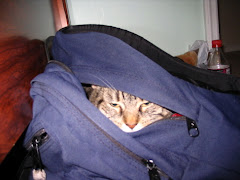
September is a busy month for publishers -- school's back in session, the holidays are nearing, and it's time to release a new season's worth of books hoping to catch the reader's fancy. Here are some new titles for young readers looking for a break from schoolwork -- look for these using the World Catalog / Amazon search boxes here on BookBag.
The Dunderheads, by Paul Fleischman (Candlewick). Fiction. When mean and nasty Miss Breakbone--who is so sadistic that she keeps an electric chair in her classroom--confiscates one student's prized possession, the whole class launches a Mission: Impossible-style caper in retaliation. With Einstein's brains, Wheels' tricked-out bike, Pencil's drawing skills, Spider's agility, and the other students' unique abilities combined, the class becomes an unstoppable force. Anyone who enjoys dramatic action and dry humor should check out this quirkily illustrated and hilarious story.
Lunch Lady and the Cyborg Substitute, by Jarrett Krosoczka (Alfred A. Knopf).Graphic Novel. As if slinging hash in the school cafeteria weren't exciting enough, Lunch Lady has a secret life as a crime-fighting superhero! And she's noticed that something about the new substitute teacher, Mr. Pasteur, just doesn't seem right. But while Lunch Lady is busy investigating Mr. Pasteur, students Hector, Terrence, and Dee are investigating her (the kids have always wondered what Lunch Lady does when she's not doling out her famous French toast sticks). If you like this wacky, action-packed comic, be sure not to miss Lunch Lady's further adventures in Lunch Lady and the League of Librarians.

Highway Robbery, by Kate Thomson (Greenwillow Books). Historical Fiction. On a cold day in 18th-century England, the poor young street urchin who narrates this story agrees to watch a stranger's magnificent horse for a golden guinea. Standing barefoot in an alley and dutifully holding the horse's reins, the boy is approached by many people who want the horse for themselves. Then a soldier in hot pursuit of the infamous robber Dick Turpin tells the boy that the horse he's guarding is actually Black Bess, Turpin's legendary steed. But who is telling the truth? This quick read is full of excitement, danger, and double-dealing and will thrill readers who like to be kept guessing.
Dragonbreath, by Ursula Vernon (Dial Books). Fiction. Danny Dragonbreath, a young dragon who hasn't yet mastered the art of breathing fire, dreams of adventure on the high seas. In reality, he gets picked on for being the only mythical creature at his school and has just received an "F" for his science paper on the ocean. With only one night to rewrite his paper, Danny convinces his best friend to come with him to the Sargasso Sea, where his cousin Edward the sea serpent lives...and where, like it or not, real adventure awaits them. With its generous amount of comic-book style art, Dragonbreath is a fun choice for fans of graphic novels like Babymouse or Sticky Burr.

The Locked Garden, by Gloria Whelan (HarperCollins). Historical Fiction. At the dawn of the 20th century, Verna and her younger sister Carlie move with their psychiatrist father and stern aunt Maude to a house on the grounds of an asylum for the mentally ill. The sisters are still mourning the loss of their mother, who died of typhoid fever two years earlier, when a young woman suffering from depression comes to live with them and serve as their maid. Verna is certain that mystery abounds at the asylum and is determined to have an adventure...but she'll have to get past Aunt Maude first. Readers who enjoy strong period details and family dramas will be enchanted by The Locked Garden.
Banned Books Week continues
From the Kansas State Collegian, Shelton Burch writes that Banned Books Week is a good way to introduce young readers to complex ideas. A careful discussion of books once banned can explore concepts that may seem unpopular or even inappropriate now. A broader topic with school-age children might be how to approach differences of opinion, or cultural and historical points of view. (The recent New York Times article about Tintin Au Congo in the previous post on BookBag is a good example.) For a list of books that have been banned, visit the American Library Association. Burch writes:
Students and faculty of the Department of English are reading America’s most debated books this week for American Library Association’s Banned Books Week.
Every year, starting on the last Monday of September, libraries and other literature-based organizations celebrate the right to express themselves, even if that expression is against what is popular or generally respected, according to the American Library Association’s Web site.
Naomi Wood, associate professor of English, said the list encompasses about every genre of literature available to the public.
“Chances are that if you’ve ever enjoyed a book, it’s probably on the list,” she said.
Wood said the idea behind Banned Books Week is that at some point or another, parents of a student in kindergarten through 12th grade saw their child reading a book and called the material within the book “inappropriate,” often asking the school to ban the book.
An example is the idea of Twain’s The Adventures of Huckleberry Finn, which was banned for its portrayal of blacks in the early 1900s. Wood said she sees this as limiting students from viewing American culture in its completion.
“If your child is reading a book like that, present them with a book that shows a more modern example rather than banning it,” Wood said. “By just denying that part of history existed, you actually cause more problems.”

































